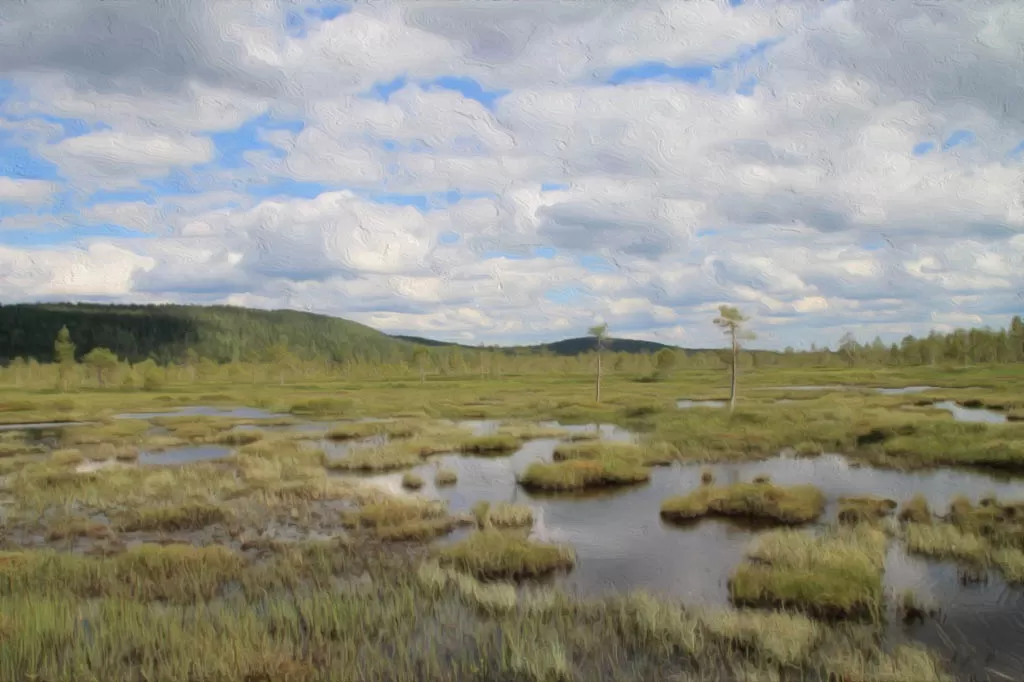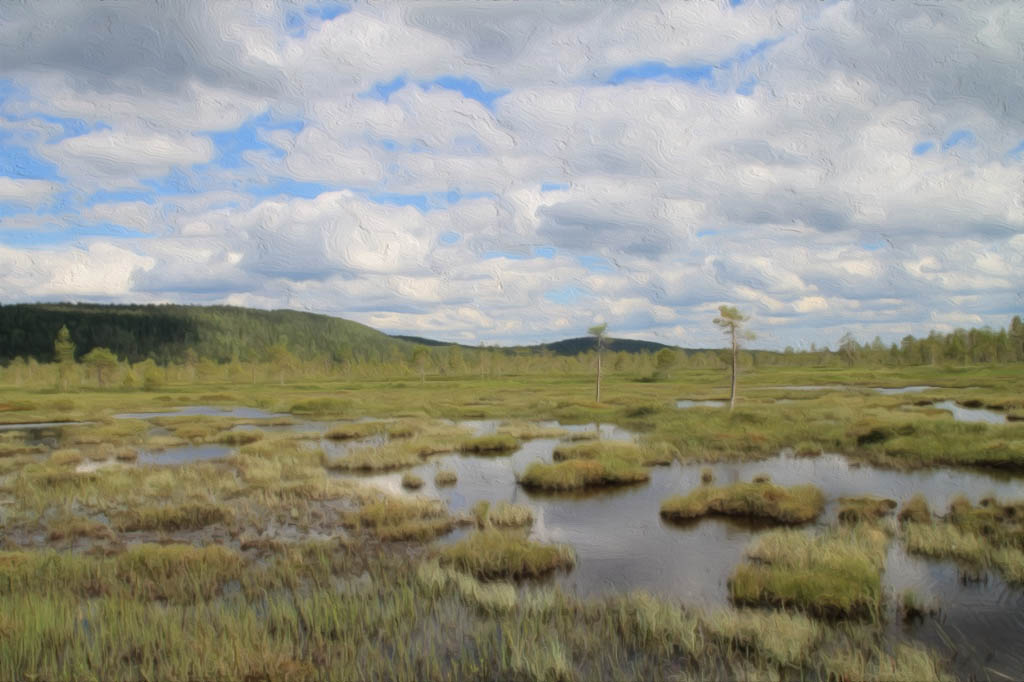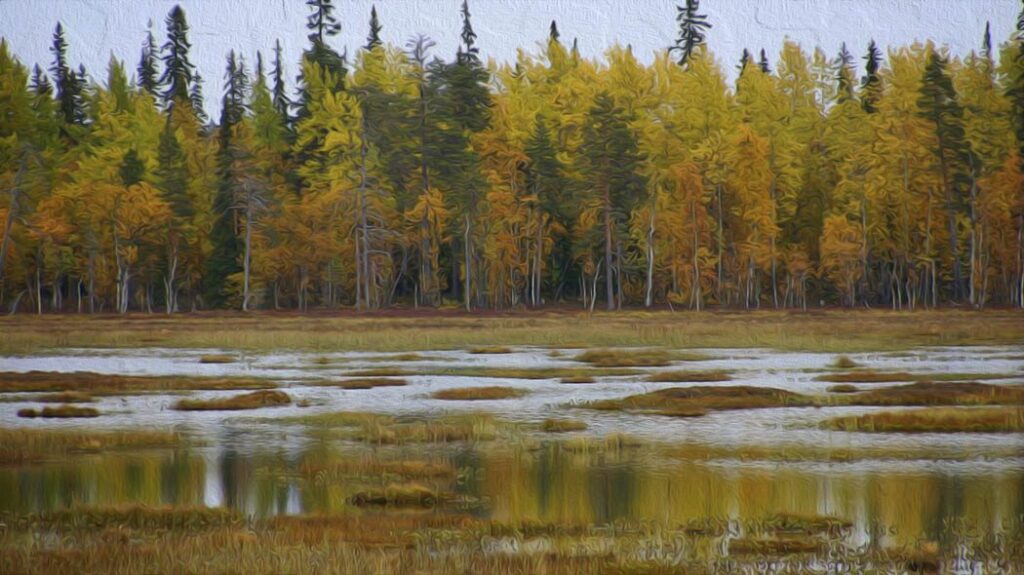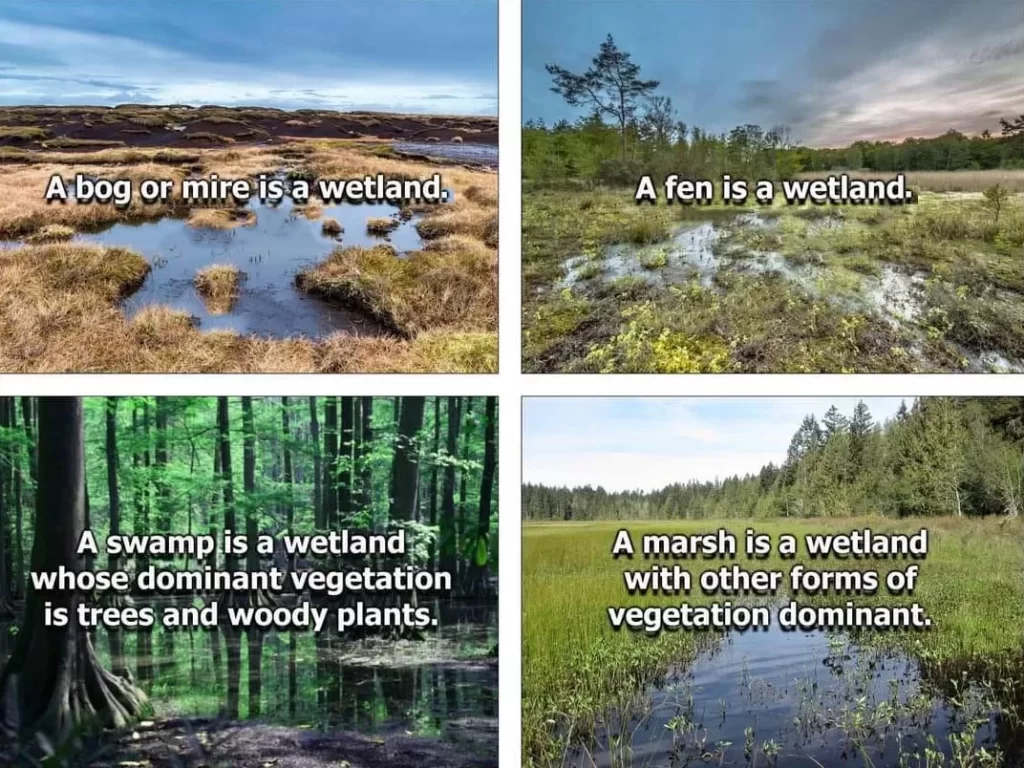
Mires, bogs and fens are all mostly open wetlands. They are dominated by plants that slowly form layers upon layers of decaying vegetation, which in the end turns into peatlands (wetland ecosystems in which waterlogged conditions prevent plant material from fully decomposing; consequently, the production of organic matter exceeds its decomposition, which results in a net accumulation of peat).
Mires can be very difficult to traverse: the decaying plant matter can be treacherous, so heavily travelled mires often have clear paths and timber boardwalks, also known as duckboards, to make travel easier and safer. However, these walkways are tempting locations for ambushes for creatures that can hide underwater, since travelers are forced to move through narrow paths that may come near ponds or cross over surprisingly deep pools.
If the characters are determined to move away from the clear paths, travel will be difficult. The spongy terrain is always considered difficult terrain, and characters must succeed in a DC 10 Constitution saving throw or a pathfinder DC 15 at the end of each hour of travel or gain one level of exhaustion. Characters can use special bog shoes so they can avoid getting stuck in the spongy moss and avoid the saving throw. Locals can often provide such equipment. A character that falls prone in a bog must use all their movement getting up instead of half.
One additional hazard in a mire are the quagmires: a soft boggy area of land that gives way underfoot. In the right conditions, decaying vegetation can float on top of a layer of water, creating a sort of a pit trap in open terrain. The DC for detecting quagmires is 12 for D&D, else +2 for Pathfinder 2e. Anyone that steps in the quagmire falls into a deep pool of water.

Visibility is rarely an issue in a mire, since plants that grow above the thick layers of moss are usually stunted. Hiding in shadows is not a possibly, so creatures that hunt here are either flying creatures, amphibian ambush predators, capable of somehow disregarding the difficult terrain, or lost and very hungry.
Humanoids have many uses for bogs. Peat can be harvested, dried and used for fuel. Berries, mushrooms, herbs and medicinal flowers bloom in the wet, sunny environments. Mires can have a ritual meaning as well. Some cultures bury their criminals in bogs, sometimes while they are still alive.
There are special encounters to consider. At times humans and other civilized humanoids may punish a criminal by sinking them into a bog. Sometimes the criminal is executed beforehand, sometimes the drowning is the execution.

One northern culture has a special kind of bronze amphora (container) they use for this exact method of execution. The arms of the criminal are broken, and the criminal is sealed within the amphora, which in turn is placed in a pool in a bog during a dry day. The mouth of the amphora is above the water, and the inside of the amphora remains empty at first, but as it starts to rain, which it often does in these parts, it begins to fill. The criminal then dies either by freezing to death in the frigid water, or the amphora fills completely, drowning the criminal.
These amphoras are often cursed, so that the souls of the criminals will not be able to depart. They may haunt the area near the amphora during the night, appearing as specters, ghosts or wraiths.


The Perils and Peculiarities of Wetland Exploration
Adventuring in the mystic and treacherous realms of mires, bogs, and fens presents a unique challenge for intrepid explorers in both Dungeons & Dragons and Pathfinder. These wetland ecosystems are not only critical to the environmental balance but also serve as formidable natural obstacles during quests. The complexity of navigating these areas, combined with the inherent dangers they present, creates a rich backdrop for dynamic and memorable campaign settings.
The Landscape of Mires
Mires, bogs, and fens are characterized by their wet, spongy ground where water collects, creating a semi-aquatic terrain dominated by a dense mat of plant material. Over time, this plant matter partially decomposes, transforming into peat. This slow decomposition process is due to the waterlogged conditions that inhibit aerobic breakdown, leading to an accumulation of organic matter.
This landscape is notoriously difficult to navigate due to the unstable ground. The surface may appear solid but often gives way under weight, leading to dangerous situations where an adventurer might suddenly find themselves stuck or even submerged in cold, murky water.
Navigational Challenges and Solutions
Due to the treacherous nature of the terrain, established paths and timber boardwalks, or duckboards, are commonly constructed to facilitate safer travel. These pathways are essential for preventing accidents and ensuring that travelers can pass through these areas without undue hardship. However, these same pathways can become strategic points of vulnerability.
Creatures adapted to the mire's environment, such as lurking predators or camouflaged monsters, might use these narrow choke points to ambush unwary travelers. The limited maneuverability on duckboards makes escape difficult, turning these crossings into potential traps for the unprepared.
Off the Beaten Path
For those daring or necessary to stray from marked paths, the mire becomes a formidable opponent in its own right. The ground off these safe routes is considered difficult terrain, significantly slowing progress. Adventurers must make DC 10 Constitution saving throws every hour to avoid exhaustion from the strenuous effort of moving through such an environment. Special bog shoes are available from locals who are accustomed to navigating these lands. These shoes spread out an individual's weight over a larger area, making it easier to walk on the spongy moss without sinking.
The Danger of Quagmires
One of the most perilous features of a mire is the quagmire, which is effectively a natural pit trap. Quagmires occur when patches of seemingly solid peat float over deeper pools of water. The difficulty in detecting these hidden traps is compounded by their natural appearance, blending seamlessly with the surrounding terrain. The detection challenge class (DC) for spotting a quagmire is typically set at 12. Unfortunate adventurers who fail to notice these traps may find themselves plunged into cold, deep waters, struggling to escape.
Survival and Strategy in Mire Settings
Survival in mires demands respect for the natural environment and preparation. Adventurers should be well-equipped with local knowledge and the right gear, such as bog shoes or ropes for self-rescue from quagmires. Additionally, traveling in such environments requires a keen eye and constant vigilance to avoid natural hazards.
Parties might find it advantageous to employ magic or abilities that allow them to manipulate the terrain or water. Spells like control water, available in both D&D and Pathfinder, or mold earth, can prove invaluable for safe passage or for rescuing companions from aquatic traps.
My Final Thoughts
Mires, with their hidden depths and deceptive paths, offer more than just physical challenges-they provide a dynamic setting for adventures that require both brains and brawn. The eerie beauty of these wetlands, combined with the dangers lurking beneath their tranquil veneer, can serve as the perfect backdrop for unforgettable campaigns that test the mettle and resourcefulness of any adventuring party.






